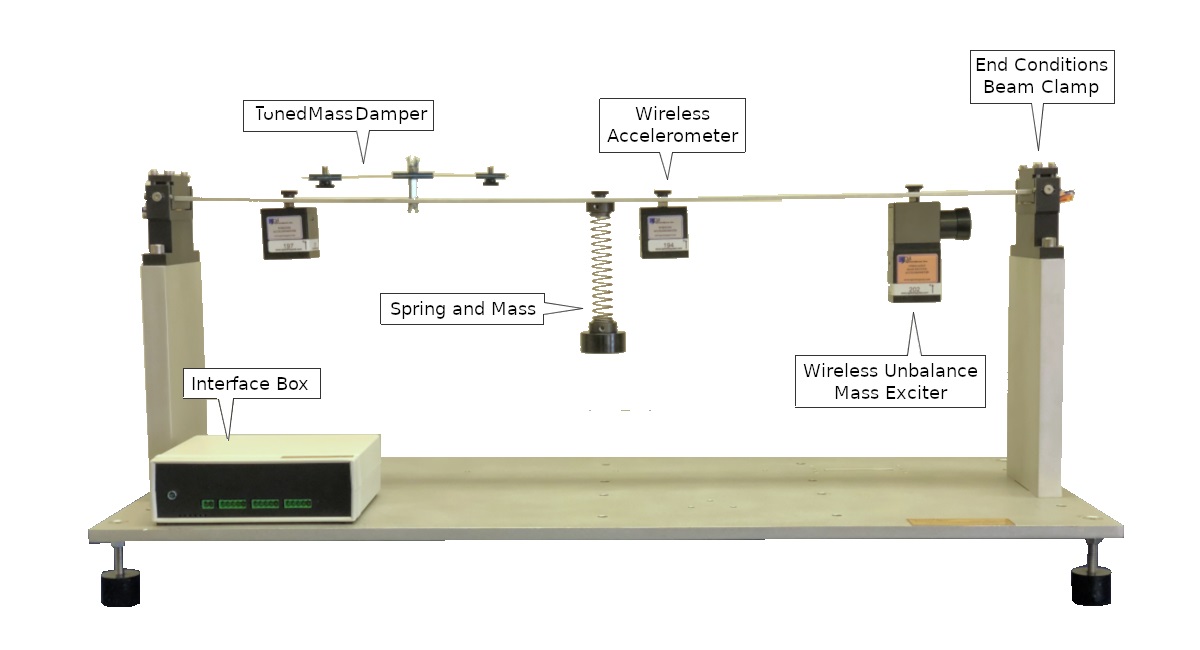Rectilinear Vibration System
 |
Print Brochure |
|
|
The Rectilinear Vibration system (alias RVS) is a turn-key integrated educational package for teaching/learning the fundamental principles of mechanical vibration along with methodologies to control the effects of vibration on structure and/or foundation. It provides both a comprehensive hands-on experimental device and an instrumentation package including wireless sensors and exciter for performing laboratory exercises to enhance student understanding of vibration theory. Students can perform virtual experiments using the vibration simulation software and then verify the results with actual experiments thereby reinforcing the learning of difficult principles. It is an ideal tool for mechanical vibration courses both at under graduate and graduate levels.
- Hands-On Turnkey System for teaching mechanical vibration fundamentals.
- Virtual experimentation combined with hands-on testing expedites learning
- Introducing Wireless Sensors & Exciter for performing True Undamped free and forced vibration experiments
- Robust, user friendly, modular, and compact bench-top device for performing controlled experiments
- Smart design enables users to perform beam experiments mimicking text book boundary conditions.
- Virtual experiment capabilities to learn the effects of parameters for each type of test configuration
Rectilinear Vibration System includes:
- Hardware for mass-spring absorber and beam absorber which includes two aluminum beam and one steel with provision for adjusting weight location and three weight blocks.
- Vibration control study module which includes a constrained layer and a viscoelastic beam.
- One dashpot and three fluids
- One unbalanced mass exciter with built-in wireless accelerometer
- Two wireless accelerometers
- DAQ unit with simultaneous sampling, time waveform, spectrum, FRF, motor control and USB connection.
- Simulation software
- Comprehensive operations manual
Beam Vibration Module
This module allows to study natural frequencies, mode shapes, and damping in beams of different materials such as steel and aluminum. The beam length is fully adjustable and can be configured with various boundary conditions Provisions to mount rigid masses at different locations and dashpot make beam completely customizable. External unbalance force of variable frequency may be applied to excite natural frequencies and produce visible mode shapes. The RVS clearly brings classical theory to life by providing a convenient mean to validate predictions and to demonstrate the influence of parameter changes on system response visually.
Vibration Control Study Module
The RVS is an ideal platform to learn passive vibration control. Students can even learn to alter excitation frequency, change resonance frequency by modifying modal mass and/or stiffness, and add damping to bring vibration levels to acceptable values. Students can also design tuned-mass damper to absorb vibration in a spring-mass system or on beam a beam using a leaf spring with sliding masses. The module also provides a constrained layer viscoelastic sandwich beam to study the effect of viscoelastic damping in vibration control. Students can use this module to study the relationship between system damping ratio/loss factor and the damping materials, damping layer thickness and damping coverage, etc.
Data Acquisition and Analysis Instrumentation
The RVS is equipped with wireless transducers, SpectraQuest proprietary multi-channel simultaneously sampled data acquisition (DAQ) system; data analysis software with automated setup for performing each experiment, simulation software, motor control module, multi-featured display, and mounting hardware/tooling. The signal analysis modules include data presentations of time waveform, FFT spectrum, and frequency response function (FRF).
Vibration Simulation/Animation
Vibration fundamentals simulation software is designed to teach basic concepts using a new interactive and visual simulation technique. The student can perform virtual experiments by changing the parameters of a vibratory system and see how the system behavior is affected. The software includes the most common topics of a typical vibration course.
Experimental Curriculum Book
The experiments book includes detailed, step by step instructions for different experiments. Students can easily follow the instructions and conduct each experiment. The instructions tell the student how to setup the hardware, connect the transducers, setup the data acquisition system, configure the data collection, and analyze the data.





